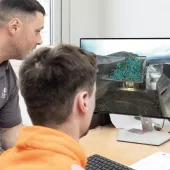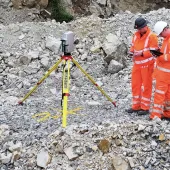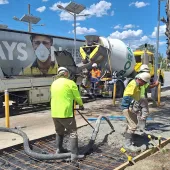Effective Quarry Blast Planning and Scheduling

First published in the March 2015 issue of Quarry Management as Planned Improvement
Cost and productivity optimization through effective blast planning and scheduling
An optimized blast plan developed between one of Australia’s largest aggregates companies and a multinational explosives supplier at a Queensland quarry has delivered significant improvements to the operation’s annual extraction plan. Karen Normanton, senior technical services engineer with Orica, outlines how the two parties were able to optimize blast performance, improve size and shape, and reduce costs per tonne of rock.
Boral’s Ormeau Quarry in the northern Gold Coast region of Queensland lies in a large zone of meta-greywacke and supplies high-quality aggregates to the asphalt and concrete markets of south-east Queensland. The site’s current capacity is around 400,000 tonnes per annum, but having recently gained approval for a development application to increase this to 2 million tonnes per annum, a project to realize this capacity has begun.
To ensure development of the quarry could meet the capacity requirements of the site, Boral and Orica worked together to:
- Improve blast size and shape
- Optimize blast performance
- Reduce the overall cost per tonne of blasted rock.
Business-improvement programme
A key element of the explosives supply agreement between Boral and Orica is the business-improvement programme. Through this programme, the two firms work through a defined process to scope, evaluate and deliver projects with significant value to Boral’s quarry operations.
A team was formed including members of Orica’s blast extraction planning team and key experts from Boral, to develop a project charter. Initial investigations showed that 17 blasts had been fired in the previous financial year to meet the production requirements for that year. It was also determined that the blasts were not optimally sized, and Orica surveyors were visiting the site more than once for each blast.
The team developed five project objectives:
- To optimize blast size to minimize the overall cost per tonne of blasted rock
- To reduce blast days per calendar year
- To deliver the required volume and blend of raw feed to meet plant capacity
- To ensure environmental compliance in line with licence conditions for blasting
- To ensure compliance with the approved life-of-mine design and any interim staged designs.
The key project outcome was to develop an easily interpretable schedule to meet the objectives stated above, while providing the quarry manager with confidence in the delivery of the required rock for current and future plant production requirements.
Technical solutions
Orica’s blast extraction planning team used several tools to deliver the objectives outlined above. They included:
- GEOVIA Surpac mine-design software
- Orica’s SHOTPlus 5 blast-design software
- Orica’s blast-scheduling tool
- Orica’s Cycad vibration-analysis software.
With these tools, a series of optimized blast blocks was first developed, after determining potential blast locations and obtaining the most current design and topographic models. Several considerations needed to be taken into account when building the blast blocks. These included:
—the required extraction rate
—the optimized blast volume
—the blast geometry
—compliance with the life-of-mine design
—environmental compliance factors
—health and safety requirements
—final product quality parameters.
A number of schedule options were then created based on specifically identified drivers for the site. These options were evaluated using Orica’s blast-scheduling tool, allowing the most effective blast-extraction plan to be determined from a productivity, blending and cost perspective. An example output from the scheduling tool is provided in figure 1.
The schedule was then developed into a blast-extraction plan that was colour-coded, making it easy to use for all personnel (see fig. 2).
Following development of the blast-extraction plan, it was possible to identify and assess any environmentally sensitive blasts and take early action to ensure blasts were designed to comply with environmental limits, without affecting the blast-extraction plan.
Results
Working together, Boral and Orica were able to:
- Increase the size of blasts, reducing blast days per year from 17 to five, which in turn increased the utilization of Orica’s mobile manufacturing units by 50%
- Reduce blasting costs by more than 20% (see fig. 3).
In addition to these benefits:
- A consistent crusher feed is being maintained at the blend ratios required by the quarry
- Blasts have been designed to take imposed environmental limits into account while maintaining the blast extraction plan
- The upper benches have been realigned to match the levels specified in the life-of-mine design.
Customer feedback
Boral Quarries said their personnel recognized the benefits of developing a 12-month extraction plan for Ormeau Quarry that fitted within the parameters of the life-of-mine design and provided the quarry manager and business with a fit-for-purpose document which optimized the extraction process, with clear actions and outcomes that met the company’s operational requirements.
The planned capacity increase for the site promises to be a step change, and having a rolling 12-month extraction plan will help the business to plan around quarry development and associated activities to meet Boral’s operational and commercial targets.
The project charter approach involving critical stakeholders, plus use of mine-development tools and techniques, such as GEOVIA Surpac and Orica’s SHOTPlus 5, were significant enablers for the project to achieve its ongoing objectives.
ACKNOWLEDGEMENTS
Orica would like to thank Neil Bellamy, Boral’s Queensland and Northern Territory drilling and blasting manager, and Liam Elsworth, quarry manager of Ormeau Quarry, for their strong collaboration and support throughout the project, and for permission to publish this case study. This article first appeared in the February 2015 edition of Quarry magazine, the official journal of the Institute of Quarrying Australia, and is reproduced here by kind permission.
- Subscribe to Quarry Management, the monthly journal for the mineral products industry, to read articles before they appear on Agg-Net








